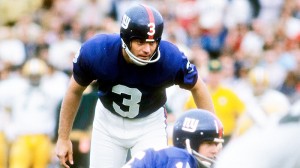What is the value of a first down? By that I mean, how many marginal yards is a first down actually worth? Here’s another way to word the question: If 3 first downs and 80 yards are worth X, then 2 first downs and [???] many yards are equal to X?
Calculating the marginal value of a yard isn’t easy. In fact, it’s been bugging me for years, because I’ve never quite been sure how to derive them. Then, a light bulb went off in my head: I needed to reach out to Brian Burke. I had an idea, but not the data or the means to execute.
Burke, of course, runs the fantastic website Advanced Football Analytics (formerly Advanced NFL Stats). I asked him if he would run some queries, and Brian was kind enough to do so. Fortunately, Brian’s not just a guy with access to lots of data, but one of the smartest minds in the industry. I wholeheartedly endorse his methods below, and I’m very thankful for his help. On top of running the numbers, he also provided an excellent writeup on his work. What follows are Brian’s words and analysis.
To estimate the value of achieving a 1st down without counting any of the value of the yardage gained, we can use the Expected Points model. The value of the 1st down itself minus yardage value will be the discontinuity in EPA when a play’s gain crosses the threshold for a 1st down. That discontinuity represents the value of the conversion apart from any yardage gained.
For example, on 2nd and 10, the EPA would increase smoothly for each yard gained up to 9 yards gained, then jump to a much higher EPA crossing the 10-yard mark where the conversion occurs. After that point, the EPA should increase smoothly again with each marginal yard gained above what was needed for the conversion.
Here is an illustration. The Y-axis represents Expected Points Added, the X-axis the amount of yards gained on the play.

The EPA for a 9-yd gain is 0.57, and the EPA for a 10-yd gain is 1.04. That’s a discontinuity of 0.47 EP, meaning that the 1st down itself is nearly equivalent to the 9-yards gained up to the point of conversion.
But we also need to correct for the yardage value of that 10th yard. One yard of field position is generally worth 0.064 EP. So in this case the discontinuity itself is worth 0.47 – 0.064 = 0.41 EP.
If we wanted to assign a “bonus” of yards to a player who is credited with achieving the conversion over and above the yardage itself, we could use this value’s yardage equivalent. 0.41 EP / 0.064 EP/yd = 6.4 yds. That’s the bonus for 2nd down and 10, but there are many other down and distance situations to consider.
For example, on 3rd and 10, the discontinuity is 1.57 EP, equivalent to nearly 25 yds. First and 10 is very strange because the discontinuity is negative. This makes sense, however, because an offense should prefer a 2nd & 1 to a 1st & 10 anywhere on the field. It would be silly to penalize a player for gaining the extra yard to convert, so my opinion would be to say the EP bonus for a conversion on 1st down is zero.

After examining a smattering of 2nd and 3rd down situations, the 2nd-down bonus EP is about 0.35 and 3rd-down bonus EP is roughly 1.4.
4th down conversions would obviously mean a very large bonus EP. They essentially have the value of a turnover–close to 4 EP or so. Since 4th downs are qualitatively different (and relatively rare) I’m going to set them aside.
In general, 32% of conversions come on 1st down, 38% come on 2nd down, and 30% come on 3rd down. So the weighted value of a conversion alone would roughly be:
[0.32 * 0] + [0.38 * 0.35] + [0.30 * 1.4] = 0.55 EP
The conversion bonus of 0.55 EP can be translated into yards by dividing by 0.064 EP/yd, which ultimately makes the equivalent yardage bonus for a conversion: 8.7 yards.
Figuring out the value of a first down will have many applications for Football Perspective going forward. Please leave your thoughts in the comments, as I’d love to hear what you guys have to say. And thanks again to Brian for his great work.




